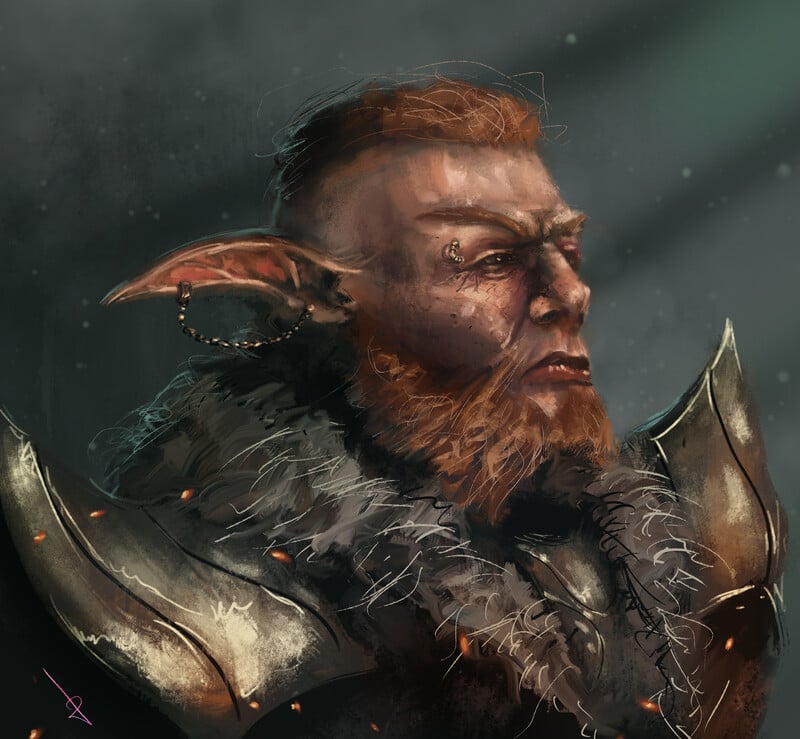Averene Dragon Elf (5e Subrace)
Dragon Elf[edit]
Physical Description[edit]

|
|---|
| Artist: Ania Kaźmierczak |
Dragon Elves are an embodiment of Viking/Nordic like features and culture. Many have a muscular build. Some of them also alter their appearance to show off draconic features such as scales or leathery skin, reptilian eyes, fangs, sharp claws, and on extremely rare occasions their tail.
Dragon Elf Origins[edit]
The Dragon Elves were once a race of Wood Elves in Versona who lived to serve golden dragons, treating them as their god. These elves worshiped golden dragons. Golden Dragons have used Dragon Elves to accomplish tasks involving security or raising and protecting their young while the dragon goes on an adventure. The origin of the first Dragon Elf is unknown but some say that they were born between dragons and the wood elven worshipers. Others say that they were born from an ancient pact that caused the two species to fuse, existing as one. Whatever the cause may be, Dragon Elves have come a long way from how they were in ancient times. Once slaves to these dragons, they are now a proud race with unbeatable respect towards one another and live in harmony with their surroundings and the dragons they once served. Recent times however, the adult Golden Dragons sacrificed themselves in the war against the Blackscale Legion, leaving only their young for the Dragon Elves to raise, eggs and wyrms remain well protected in the capital of Versona, Gromsfel.
Society[edit]
The society of Dragon Elves is viking-like. What is known about them is that they don't get along with other Elves from different bloodlines, especially Wood Elves, who were the aboriginal race of Averene. Similarly to Dragon Elves, Wood Elves prefer isolation and that lead the Dragon Elves to make reservations seperated by wood elf tribes. They love to hoard treasures and are more arrogant than the Wood Elves. And compared to the Wood Elves, Dragon Elves are rarely seen traveling or living with other races, while some tribes of Wood Elves often have adopted Centaurs and Satyrs into their tribes. Dragon Elves are more commonly seen on the roads or in towns. Though Wood Elves are much more social and enjoy the company of other races with the exception of Dragon Elves and thus aren't often seen in Dragon Elf towns with any other purpose than coin and trade.
Kingdom and Culture[edit]
Dragon Elves commonly live with other Dragon Elves, and proudly serve the Kingdom of Gromsfel. They also live among young golden dragons and avoid living in multicultural societies. To a Dragon Elf, their kin's safety is more valuable than life itself. Unlike their ancestors who devoted their lives to the dragons, the generations of Dragon Elves after the ‘big change’ have come to co-exist with dragons, protecting and respecting each other. One of the oldest traditions within the Dragon Elf culture is the Alye'varahk. The Alye’varahk is a tradition where each new-born Dragon Elf is given a wyrmling to raise/grow up with. As the two grow, they will have to work together to get through struggles and challenges with the help of the other Dragon Elves and dragons but once they reach adulthood, they are usually made to travel. Since Dragon Elves are so long-lived, their individual clans usually have them leave while in early stages of adulthood to explore and discover the world around them. Through this experience, the Dragon Elves will learn new ways of fending for themselves by exercising their martial prowess or gaining greater control over their innate magical powers. Some may join parties of other adventurers on their journey, and might even become champions of a land.
Dragon Elf Names[edit]
At birth, Dragon Elves are named by the high lord of their clan. The name could be something ordinary, or complex, but will always have their clan name in it. For example, a highly noted Dragon Elf is known by the name, Drakonius Vael (pronounced Vay'eel) which holds the name of their clan, 'Draconius' in addition to his birth name, 'Vael'.
Elf Subrace[edit]
Your Dragon Elf has the following traits in addition to the base racial traits of the elf.
Ability Score Increase. Your Constitution score increases by 1.
Draconic Empathy. Whenever you make a Charisma check when interacting with dragons, your proficiency bonus is doubled if it applies to the check. Additionally, if you know the find familiar spell, you can choose to have your familiar take the form of a pseudodragon instead of one of the normal forms.
Draconic Resistance. You have resistance to one damage type of your choosing from: acid, cold, fire, lightning, or poison.
Elf Weapon Training. You have proficiency with the longsword, shortsword, shortbow, and longbow.
Extra Language. You can speak, read, and write Draconic.
Original Content of this Page can be found here
[1], simply tweaked some information.
Back to Main Page → 5e Homebrew → Character Options → Subraces
